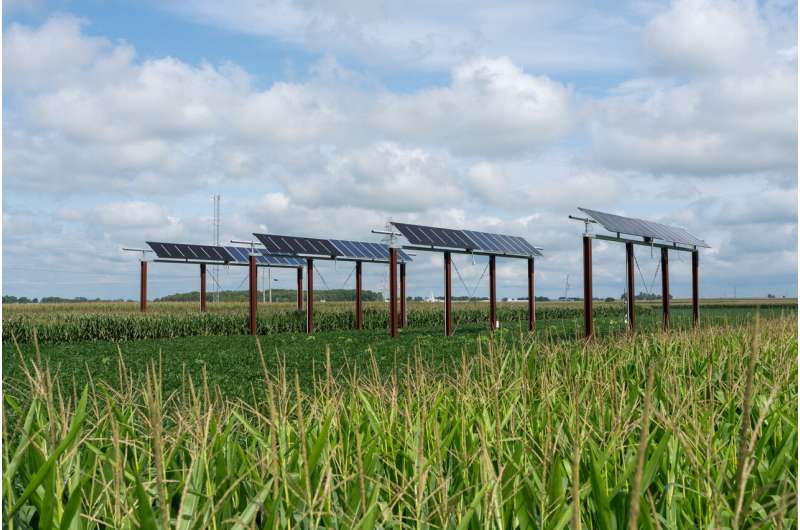
A Purdue University research team has demonstrated how to optimize yield in corn fields equipped with solar power arrays that throughout the day cast dynamic shadows across growing crops.
The team of eight researchers from Purdue University and Aarhus University in Denmark published their findings July 26, 2024, in Cell Reports Sustainability.
Solar panel arrays—photovoltaics—normally cast permanent shadows on the ground throughout the day. Permanent shadow on a farm field would harm crop growth. The Purdue team tested an agrivoltaics system that towers high above the crops to permit combine harvester operations.
The system tracked the sun during daylight hours. With constantly moving panels, every corn row received different light intensities throughout the day, but none sat under steady shadow.
"We developed a model to calculate what fraction of light is falling on each row," said co-author Rakesh Agrawal, the Winthrop E. Stone Distinguished Professor of Chemical Engineering at Purdue.
Armed with the Purdue team's working plant growth and light intensity (dynamic shadow) models, researchers now can ask critical what-if questions. What if the solar panels operated at lower heights? What if they were brought closer together, or farther away from each other? And what if they grew a shorter variety of corn?
"One season is one data point. If you want to change your variables, there's only one summer every year, so if we change the height, you can grow only one crop that year to measure the impact," Agrawal said. But with the simulations, photovoltaics manufacturers, power companies and farmers alike can ask several what-if questions and quickly test multiple options.
The panels in the Purdue experiment stood 20 feet high. But the modeling has already shown that panels 10 feet high would produce similar results with much lower construction costs.
"We are showing the world that, for corn, such a thing can be done and it works very well," Agrawal said.
Co-author Margaret Gitau, professor of agricultural and biological engineering, noted that in some situations, agrivoltaics can also affect field microclimate in ways that promote the climate resilience of crops.
"Some areas could experience wetter, cooler conditions, while in other areas, conditions might be no different than in areas without solar panels," Gitau said. "Shading provided by the panels can be important in conserving moisture in areas that experience water and temperature stress during particularly dry periods."
Agrivoltaics also offer the potential to build self-sustaining water systems. Runoff or drainage waters could be collected and recycled to provide supplemental irrigation using power generated on-site, she said.
Most U.S. agrivoltaics work focuses on specialty crops such as Brussels sprouts, raspberries, cabbages and peppers. But those crops occupy a small land percentage when compared to row crops.
In 2022, corn, soybeans and wheat encompassed more than 200 million acres in the U.S., according to the Food and Agriculture Organization of the United Nations.
More information: Varsha Gupta et al, Optimizing corn agrivoltaic farming through farm-scale experimentation and modeling, Cell Reports Sustainability (2024). DOI: 10.1016/j.crsus.2024.100148
Citation: Validated simulations optimize solar power generation with row-crop agriculture (2024, August 20) retrieved 20 August 2024 from https://techxplore.com/news/2024-08-validated-simulations-optimize-solar-power.html
This document is subject to copyright. Apart from any fair dealing for the purpose of private study or research, no part may be reproduced without the written permission. The content is provided for information purposes only.
